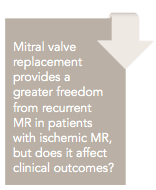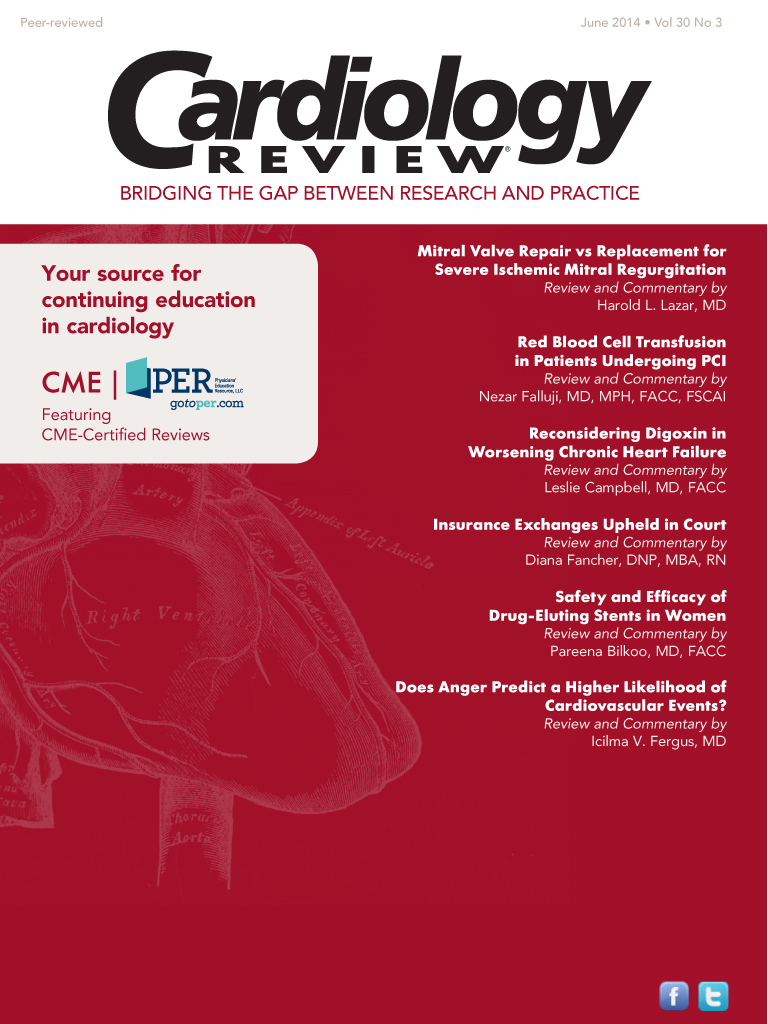Mitral Valve Repair vs Replacement for Severe Ischemic Mitral Regurgitation
Mitral valve replacement provides a greater freedom from recurrent MR in patients with ischemic MR, but does it affect clinical outcomes?

Harold L. Lazar, MD
Review

N Engl J Med.
Acker MA, Parides MK, Perrault LP, et al. Mitral-valve repair versus replacement for severe ischemic mitral regurgitation. 2014;370:23-32.
I
schemic Mitral Regurgitation (MR) is often seen in patients undergoing coronary artery bypass graft (CABG) surgery. In those patients with ≤2+MR at the time of surgery, surgical revascularization with aggressive medical management, including afterload reduction with angiotensin-converting enzyme inhibitors, will successfully reduce MR in the vast majority of patients. However, for those patients with severe ischemic MR (≥3+), a mitral valve procedure will be necessary.
Study Design
As noted by Acker and colleagues, ischemic MR is due to myocardial dysfunction and not to a valve leaflet abnormality. Hence, emphasis has been placed on repairing these “normal” valves rather than replacing them. In this multicenter randomized trial involving 251 patients from the Cardiothoracic Surgical Trials Network, the investigators sought to determine the benefits of repair versus replacement in patients with severe ischemic MR.1 Nearly three-fourths of these patients underwent a concomitant CABG, and none of the patients had any echocardiographic evidence of structural (leaflet, chordal, papillary muscle) dysfunction. Severe MR was defined as an effective regurgitant orifice of 0.4 cm2 or more. Mitral valve replacement was performed with either a mechanical or biological prosthesis, and preservation of the subvalvular apparatus (ie, preservation of the posterior leaflet and/or a portion of the anterior leaflet). Repairs were performed using rigid or semi-rigid complete annuloplasty rings, which were downsized for the diameter of the annulus. These are standard techniques commonly used by all cardiac surgeons.
P
There was no difference in the primary end point: left ventricular end-systolic volume index (LVESVI) at 1 year. Similarly, there was also no difference in 30-day or 1-year mortality, heart failure, stroke, incidence of composite major adverse events, functional state, or quality of life. However, the incidence of recurrent moderate or severe MR at 1 year was significantly higher in the replacement group (32.6% vs 2.3%; <0.001). The authors concluded that mitral valve replacement provided a greater freedom from recurrent MR in patients with ischemic MR, but after 1 year this did not affect clinical outcomes.
CommentaryA 1-Year Follow-Up May Not Be Long Enough
T
he findings of this trial are consistent with my own observations in this group of patients. While it may be surprising that the incidence of recurrent MR did not influence clinical outcomes, the follow-up period was relatively short—only 1 year. A longer period of time might be necessary to show the benefits of reducing MR on cardiac-related morbidity and mortality in these patients. The high mortality rate in both groups at 1 year (14.3% repair vs 17.6% replacement) is indicative of the multiple comorbidities in these patients and the poor prognosis associated with severe ischemic MR. Mitral valve replacement is more effective in reducing long-term ischemic MR, but in this patient population, it may not necessarily relate to improved survival—at least after 1 year.
The discrepancy between the findings of this trial and those of previous studies is due to several factors. In prior studies, rings were used to treat patients with ≤ 2+MR, a condition that can be treated with revascularization and medical management. Patients may have developed significant MR only in the operating room that was ischemia-related during the time when conduits were harvested prior to going on cardiopulmonary bypass, and therefore they received a ring. Merely performing the revascularization alone and alleviating the ischemia may have been all that was needed in these patients. In the current trial, the degree of MR was assessed preoperatively and not in the operating room, and the decision to proceed with a valve procedure was made prior to surgery. Patients undergoing mitral valve replacement may not have had preservation of their chordal apparatus, as was the case in previous studies, which can result in a further deterioration of postoperative LV function and ejection fraction.
Should annuloplasty rings be avoided in these patients? In those patients treated with a repair using a ring and who did not have recurrent MR, there was a 22.6% reduction in LVESVI from baseline, compared with only a 6.8% reduction in the replacement group. Hence, this suggests that if recurrent MR can be eliminated, mitral repair may result in more reversal of adverse ventricular remodeling than is possible with mitral valve replacement.
Ischemic MR is the result of several adverse remodeling issues that can influence the type of repair necessary to result in a competent valve.2 The global injury that results in enlargement of the LV and mitral annular dilatation results in malcoaptation due to a central regurgitant jet. This is best treated with a rigid complete annuloplasty ring, which is downsized from the distance measured between the anterior trigones. For example, if the distance between the trigones is suitable for a #31 ring, then a #29 ring is necessary to achieve leaflet coaptation. On the other hand, if the injury is associated not only with LV enlargement but a regional wall abnormality resulting in displacement of the papillary muscles and leaflet tethering, then there will be asymmetrical closure of the leaflets and a simple ring annuloplasty will fail. Other techniques such as chord-cutting or the use of neochords to realign the leaflets, along with an annuloplasty ring, may be required.3 When repairing ischemic MR, the repair should be tailored to the specific abnormalities of the annulus and subvalvular apparatus guided by echocardiography in order to achieve a successful result.4
Other issues are also important in determining whether an ischemic mitral valve should be repaired or replaced. These include the size of the left atrium and how well the valve can be visualized, the urgency of the surgery, and how comfortable the surgeon feels in spending the extra time that may be necessary to perform a more complicated repair. The need to go back on cardiopulmonary bypass following a repair that resulted in significant residual MR can result in increased morbidity and mortality for these patients.
In summary, this trial has reaffirmed that despite correction of MR, patients with ischemic MR still have a poor long-term prognosis. Mitral valve replacement is a more reliable technique to limit recurrent MR but does not improve survival or reverse adverse ventricular remodeling after 1 year. Simple ring annuloplasty is not sufficient to alleviate MR when there are changes in both the annulus and the subchordal apparatus. More long-term follow-up from this trial will be necessary to determine whether the improved freedom from recurrent MR in the valve replacement group will translate into better long-term survival and decreased morbidity after 1 year. In addition, more studies are necessary to determine whether repairs that take into account changes in both the annulus and subvalvular apparatus will limit the degree of recurrent MR and lead to better ventricular remodeling and, as a result, improve survival and decrease morbidity.
 
References
N Engl J Med.
1. Acker MA, Parides MK, Perrault LP, et al. Mitral valve repair vs. replacement for severe ischemic mitral regurgitation. 2014; 370:23-32.
Cardiology.
2. Magne J, Senechal M, Dumesnil JG, Pibarot P. Ischemic mitral regurgitation: A complex multifaceted disease. 2009;112:244-259.
J Thorac Cardiovasc Surg.
3. Borger MA, Murphy MPM, Alam A, et al. Initial results of the chordal-cutting operation for ischemic mitral regurgitation. 2007;133:1483-1492.
Circ Cardiovasc Imaging.
4. Drake DH, Zimmerman KG, Hepner AM, Nichols CD. Echo-guided mitral repair. 2014;7:132-141.
About the Author
The Journal of Cardiac Surgery.
Harold L. Lazar, MD, is professor of cardiothoracic surgery at Boston University School of Medicine and the Boston Medical Center, Boston, MA. He received his MD from Boston University, completed his residency in general surgery at the University of Michigan Medical Center in Ann Arbor, and did his cardiothoracic residency at Columbia-Presbyterian Medical Center in New York, NY. Dr. Lazar has lectured widely and is the author of numerous journal articles and book chapters. He is editor-in-chief of
